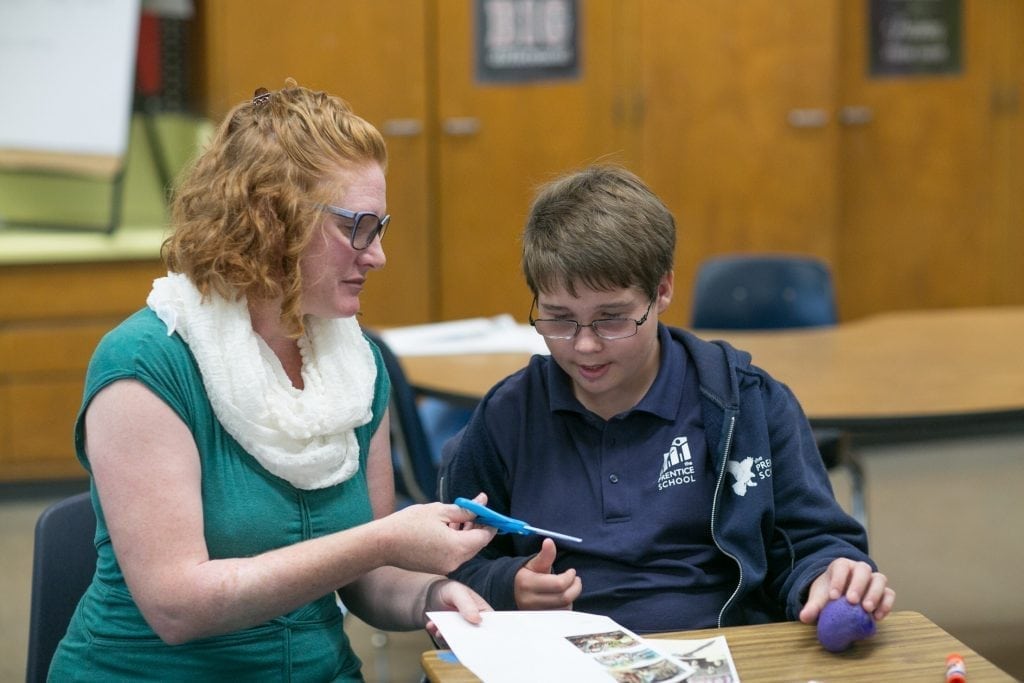
Junior high teacher Micki Simon works with a student at The Prentice School. PHOTO COURTESY THE PRENTICE SCHOOL
While research over the years has continued to yield much information about dyslexia, the learning disorder is still easily misunderstood. These misconceptions can lead to ineffective approaches to learning, doing a disservice to those with the disorder. Debunking some of the myths surrounding dyslexia can lead to better outcomes for everyone involved.
Here are the facts about four of the most common misconceptions about dyslexia:
Misconception: Dyslexia is a visual problem. While some people with dyslexia have problems with their vision, the disorder is not just about the way a person sees letters and numbers. The issue lies within the brain and how it processes written material. Often, letters or numbers appear out of order or even backwards. The text that is viewed through the eyes does not make sense because of the way the brain is wired.
Msiconception: Dyslexia can be outgrown. Hopeful as some may be, there is no such thing as a former dyslexic. It is a lifelong issue, whether it is diagnosed during childhood or later in life. There are no vision exercises, special glasses or medications that can remedy the disorder. Children with dyslexia inevitably become adults with dyslexia. There are, however, effective strategies that make reading and writing easier for them.
Misconception: Dyslexia cannot be diagnosed in young children. Many believe that tests to diagnose dyslexia cannot be successfully performed until a child is in third or fourth grade and failing at reading. This “wait-to-fail” approach can have tremendous psychological and clinical implications for the child. Screening can be done even before a child enters school, as children as young as 3 have shown deficits in their knowledge of letters and phonological awareness.
A number of screening tests can identify children who may be at risk for experiencing difficulty reading. Studies show that the brain is able to adapt to change when it is young, and that learning certain skills becomes more difficult as we age. Thus, it is beneficial to discover the disorder earlier in order to make preventive intervention and special education services available as necessary.
Misconception: Dyslexia means low intelligence. People with dyslexia have trouble with letters or deciphering words, but that does not mean they are not smart. People with dyslexia can be creative and bright, and with the right accommodations to assist them with reading, can perform very well in school. Some of the brightest minds in history – Albert Einstein, Henry Ford, Thomas Edison, George Washington and Leonardo da Vinci – have had dyslexia.
While students with dyslexia have to work harder than their classmates to learn how to read well, this does not mean they are any less intelligent than someone without the disorder who learns to read and write with ease. Ronald D. Davis, author of “The Gift of Dyslexia,” believes all people with dyslexia share the same talents:
- They can use the brain’s ability to alter and create perceptions (the primary ability).
- They are highly aware of the environment.
- They are more curious than average.
- They think mainly in pictures instead of words.
- They are highly intuitive and insightful.
- They think and perceive multidimensionally (using all the senses).
To properly teach, support and intervene in the education of a child with dyslexia or any learning difference, we must understand the challenges associated with it and put to rest the fallacies that are tied to it. Educators must be informed so that they can offer proper teaching techniques, and parents must know the facts so that they can advocate for their children.
Micki Simon, B.A., is a junior high teacher at The Prentice School in Tustin. She teaches 6th grade and is in the process of pursuing a Special Education Credential. The Prentice School offers an unparalleled learning experience to students with learning differences who possess average-to-high intelligence and whose needs have not been met in a more traditional classroom setting.























